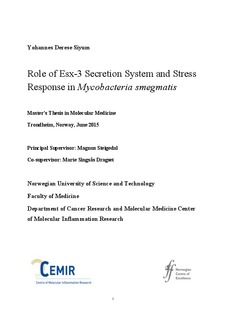| dc.description.abstract | Background: Bacteria secrets proteins to manipulate their growth environments through
various secretion systems. Type VII systems are important protein secretary systems known
in mycobacteria. 5 different Type VII systems are predicted with different function which
named as Esx-1 to Esx-5. Protein secretion and some function of Esx-1, Esx-3 and Esx-5
have been shown in several studies. Esx-4 and Esx-3 are the only systems conserved in every
species of mycobacteria and Esx-3 has an essential role in most species. Esx-3 secretion
system has an important role in mycobacterial iron uptake. Iron is an essential element
important for cellular metabolism and oxygen transport. Unregulated iron could lead to
harmful toxic radical formation. Mycobacteria must carefully regulate iron to survive and
establish infection or stay dormant inside host. Despite the importance of Esx-3 for iron
metabolism there is some evidence that Esx-3 would also be involved in other processes.
Aim: The aim of this study was to identify novel function of Esx-3 secretion system by
evaluating gene expression of genes in central metabolic processes.
Objectives: To investigate transcription, we wanted to optimize high quality mycobacteria
RNA extraction methods. For gene expression analysis, we used NanoString technology to
identify role of mycobacterial Esx-3 system in different metabolic processes. Evaluate esx-3
mutant M. smegmatis stress responses in solid and liquid media and determine localization of
Esx-3 proteins in M. smegmatis by cloning with gateway cloning system and confocal
microscopy.
Result: 107 M. smegmatis genes were screened by NanoSting gene expression analysis. Most
of expression in redox regulatory, iron regulatory and iron dependent repressor genes were
affected in esx-3 mutant M. smegmatis. We revealed for the first time that under high iron
media, almost all screened redox regulatory genes were down regulated in esx-3 mutant M.
smegmatis. Expression of ahpC gene in esx-3 mutant M. smegmatis challenged with H2O2
was upregulated in both low and high iron condition whereas katG was upregulated only
under low iron H2O2 exposure. In the absence of H2O2, katG was upregulated only in WT
under high iron condition. Based on the expression data we investigated the tolerance of the
esx-3 mutant towards H2O2 stressor both in solid and liquid media and under low and high
iron conditions. Our experiments showed that mutant had higher tolerance to H2O2 compared
to both wild type and mycobactin mutant M. smegmatis under all conditions tested. Part of
the biological function of a protein is the correct localization. We in investigated the
iii
localization of important Esx-3 proteins and found that EccB3 protein was observed as strong
fluorescent large beads on average 2 – 3 per bacteria with predominantly polar localization
whereas; EspG3 was seen as small green fluorescent dots scattered throughout the bacterium,
with more dots per cell than in EccB3.
Conclusion: Esx-3 could be negatively regulated by both furA and ideR. Esx-3 could also
involve in ahpC oxidative stress response, possibly through gene regulation. Defects in one
of the repressor furA or ideR will indirectly affects the function of Esx-3 and increase M.
smegmatis oxidative stressor susceptibility. Further study is required to investigate how esx-3
is regulated by furA and ideR and role of Esx-3 in oxidative regulatory genes. The
experiment also should be repeated in pathogenic mycobacteria species. | nb_NO |
